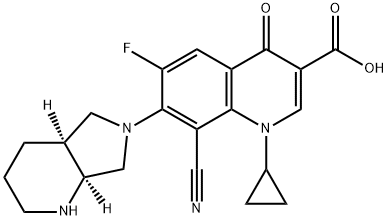
Прадофлоксацин
- английское имяPradofloxacin
- CAS №195532-12-8
- CBNumberCB12515848
- ФормулаC21H21FN4O3
- мольный вес396.41
- номер MDLMFCD28127006
- файл Mol195532-12-8.mol
| Температура плавления | 246-248°C |
| Температура кипения | 664.5±55.0 °C(Predicted) |
| плотность | 1.50±0.1 g/cm3(Predicted) |
| пка | 6.38±0.50(Predicted) |
| Справочник по базе данных CAS | 195532-12-8 |
| FDA UNII | 6O0T5E048I |
рисовальное письмо(GHS)
-
рисовальное письмо(GHS)


-
сигнальный язык
предупреждение
-
вредная бумага
H302:Вредно при проглатывании.
H341:Предполагается, что данное вещество вызывает генетические дефекты.
-
оператор предупредительных мер
P201:Беречь от тепла, горячих поверхностей, искр, открытого огня и других источников воспламенения. Не курить.
P202:Перед использованием ознакомиться с инструкциями по технике безопасности.
P264:После работы тщательно вымыть кожу.
P270:При использовании продукции не курить, не пить, не принимать пищу.
P281:Пользоваться надлежащим индивидуальным защитным снаряжением.
P301+P312:ПРИ ПРОГЛАТЫВАНИИ: Обратиться за медицинской помощью при плохом самочувствии.
P308+P313:ПРИ подозрении на возможность воздействия обратиться за медицинской помощью.
P405:Хранить в недоступном для посторонних месте.
P501:Удалить содержимое/ контейнер на утвержденных станциях утилизации отходов.
Прадофлоксацин химические свойства, назначение, производство
Использование
Pradofloxacin is a novel fluoroquinolone antibiotic. An antimicrobial agent.Показания
Dogs: Pradofloxacin is a novel third-generation fluoroquinolone currently approved in Europe to treat canine wound infections and superficial and deep pyoderma associated with susceptible strains of Staphylococcus pseudinterme- dius. However, it has shown lower minimal inhibitory concentration (MIC) when compared to various fluoroquinolones for the following organisms: Bordetella, Escherichia coli, Enterococcus, Klebsiella pneumonia, Staphylococcus, Staphy- lococcus pseudintermedius, Streptococcus, Pseudomonas, Proteus, Mycoplasma, Salmonella, and Pasteurella. Moreover, in contrast to other fluoroquinolones, pradofloxacin has shown excellent in-vitro activity against anaerobic bacteria isolated from dogs and cats. Pradofloxacin, concurrently with topical therapy, may also be of benefit for treatment of chronic ear infections, particularly otitis media, caused by susceptible organisms such as Pseudomonas. However, tissue concentration is not known for the external or middle ear, and this indication is controversial with unpredictable efficacy.Note: The authors do not recommend the use of fluoroquinolones as first-line therapy for pyoderma. Fluoroquinolones should be considered primarily for chronic deep pyodermas associated with extensive scar tissue, because of their excellent tissue penetration. Antibiotic selection, however, should be based on culture and susceptibility results.
Механизм действия
Pradofloxacin is a third-generation fluoroquinolone that inhibits DNA supercoiling and synthesis by inhibition of bacterial DNA gyrase and topoisomerase IV. Because of these two fluoroquinolone targets, development of resistance is less likely than with other fluoroquinolones. Similarly to other fluoroquinolones, pradofloxacin accumulates inside inflammatory cells, in particular in macrophages.Побочные эффекты
Dogs: pradofloxacin is generally well tolerated, but it may cause nausea, vomiting, diarrhea, soft stools, lethargy. These signs are typically mild and transient. It can induce seizure when administered at high doses.взаимодействия лекарств
Antacids containing divalent or trivalent cations (e.g., Mg++, Al++, Ca++), iron, zinc: decrease pradofloxacin absorption; separate administration of these products and pradofloxacin by at least 2 hoursAminoglycosides, third-generation cephalosporins, extended spectrum penicillins: drug synergism may occur, especially against Pseudomonas
Digoxin: may increase oral bioavailability of digoxin Cyclosporine: may reduce the metabolism of cyclosporine
Methotrexate, theophylline: may increase the blood levels of these drugs
Nitrofurantoin: may reduce the antimicrobial effect of fluoroquinolones
Прадофлоксацин поставщик
| поставщик | телефон | страна | номенклатура продукции | благоприятные условия |
|---|---|---|---|---|
| +undefined-21-51877795 | China | 32965 | 60 | |
| +86-0571-85134551 | China | 15352 | 58 | |
| +86-0512-83500002 +8615195660023 |
China | 23046 | 58 | |
| +16313385890 | United States | 3868 | 58 | |
| 025-57798810 | China | 3239 | 55 | |
| 021-52996696,15000506266 15000506266 |
China | 4589 | 55 | |
| 021-51619050 13301662590 |
China | 7823 | 55 | |
| 17754423994 17754423994 |
China | 8011 | 62 | |
| 021-QQ:65489617 15618227136 |
China | 7316 | 58 | |
| 021-54285032 18116461626 |
China | 142 | 58 |